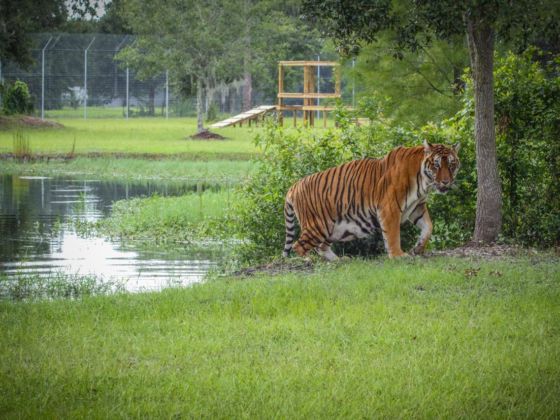Full disclosure: I’m a cat-lover. While some people might find their behavior aloof (or even evil), I’m fascinated by it. Maybe I think they’re so complex and I have an urge to understand them, while at the same time knowing I never will. I’m even more amazed by big cats — the tigers, leopards, and lions of the world. To see domesticated cats’ mannerisms in these incredible creatures (or vice versa) always astonishes me.

Big Cat Rescue: Florida's Sanctuary for Abused and Neglected Big Cats
I was recently in Tampa, Florida and discovered that there’s a sanctuary that rescues big cats from all over the United States. They find the cats in the most horrible conditions: in tiny backyard cages, in roadside zoos, in traveling circuses. Sometimes they’re used by drug dealers as guards. We were told one story by Susan, our guide on the day we visited Big Cat Rescue, of a serval — a wild cat native to mostly sub-Saharan Africa — whose owner decided that because she was a vegan, her cat would be vegan also. In the wild these cats are carnivores, so you can imagine what that did to it. In many cases, people find that they just can’t care for a big cat so they ditch them. According to Big Cat Rescue, there are an estimated 10,000 to 20,000 big cats living in deplorable conditions in the US, who get abused, neglected, abandoned, and killed for their fur coats.
Big Cat Rescue is accredited
Big Cat Rescue is “one of the world’s most effective accredited sanctuaries for exotic cats” and they’ve been rescuing big cats since 1992. The 501c3 charity is accredited by the Global Federation of Animal Sanctuaries (GFAS) whose goal is to “ensure that these animals receive the highest standards of care during rescue, rehabilitation, and the rest of their life.” The GFAS is the only worldwide accreditation organization and they have strict standards to meet to become certified, which include guidelines on (among many others):
- housing
- nutritional requirements
- veterinary care
- safety policies, protocol, and training
- education and outreach
There are many places that use “rescue” and “sanctuary” in their names, but this does not necessarily mean that they’re great for the animals. For example, some places will allow visitors to touch or handle animals, or rent them out for specific purposes like a video or photo shoot. An accredited sanctuary will not. At Big Cat Rescue the cats are pretty much left alone except when being fed or for any veterinarian treatments.
What you can and can’t do at Big Cat Rescue
You can visit the sanctuary, but you can’t explore the 67-acre grounds on your own. The cats are contained in large areas by secure fencing but for the cats’ and visitors’ safety and well-being, the staff provides guided tours for small groups (or private one-on-one tours). There’s an onsite gift shop where proceeds go to fundraising efforts, and where you can also make donations (you can also shop and donate online at their website).
Ending exotic cat ownership in the US
Right now Big Cat Rescue is behind efforts to legislate the Big Cat Public Safety Act HR1818, a federal bill that would “end the private possession of big cats as pets, end cub petting, and limit exhibitors to those who do not repeatedly violate the law.” For US residents, this is something you can tangibly do to help by contacting your members of Congress to champion the bill and get it passed. To learn more about helping, go here.
How to visit Big Cat Sanctuary
The sanctuary is located just north of Tampa, Florida, only a 15-minute drive from Tampa International Airport. Before you go you’ll need to pre-book into one of their daily tours. These do fill up so make sure you do so well in advance. You can book tickets on this page. If you can’t visit in person you can visit their YouTube channel where they’re constantly adding educational videos. They also have a livestream that you can access through their website.